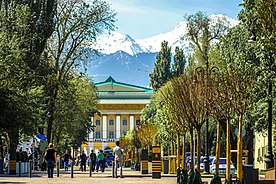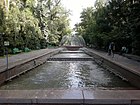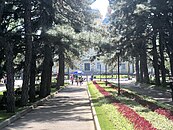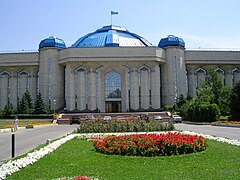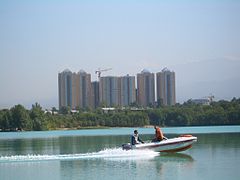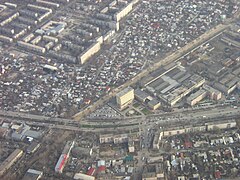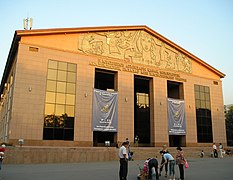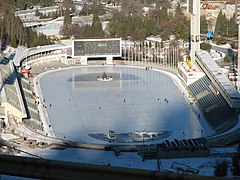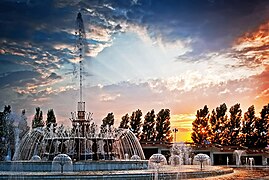world.wikisort.org - Kazakhstan
Almaty (/ˈælməti/; Kazakh: Алматы; Kazakh pronunciation: [ɑlmɑˈtə] (![]() listen)), formerly known as Alma-Ata (Kazakh: Алма-Ата), is the largest city in Kazakhstan, with a population of about 2 million.[5] It was the capital of Kazakhstan from 1929 to 1936 as an autonomous republic as part of the Soviet Union, then from 1936 to 1991 as a union republic and finally from 1991 as an independent state to 1997[6] when the government relocated the capital to Akmola (renamed Astana in 1998, Nur-Sultan in 2019, and back to Astana in 2022).
listen)), formerly known as Alma-Ata (Kazakh: Алма-Ата), is the largest city in Kazakhstan, with a population of about 2 million.[5] It was the capital of Kazakhstan from 1929 to 1936 as an autonomous republic as part of the Soviet Union, then from 1936 to 1991 as a union republic and finally from 1991 as an independent state to 1997[6] when the government relocated the capital to Akmola (renamed Astana in 1998, Nur-Sultan in 2019, and back to Astana in 2022).
Almaty
Алматы | |
|---|---|
City | |
|
Clockwise from top: Panfilov Street Esplanade, Ascension Cathedral, Kok Tobe cable car, Skyline of Almaty, KBTU Building, Abay Opera House. | |
 Flag  Coat of arms | |
| Nicknames: South Capital, Apple City, Big Apple | |
 Almaty Location in Kazakhstan  Almaty Almaty (Asia) | |
| Coordinates: 43°16′39″N 76°53′45″E | |
| Country | |
| First settled | 1000–801 BC |
| Founded | 1854 |
| Incorporated (city) | 1867 |
| Subdivisions | 8 districts |
| Government | |
| • Body | City Mäslihat |
| • Akim | Yerbolat Dosaev |
| Area | |
| • City | 682 km2 (263 sq mi) |
| • Metro | 9,395 km2 (3,627 sq mi) |
| Highest elevation | 1,700 m (5,600 ft) |
| Lowest elevation | 500 m (1,600 ft) |
| Population (1 January 2021)[1] | |
| • City | 1,977,011[2] |
| Time zone | UTC+6 (UTC+6) |
| Postal code | 050000–050063 |
| Area code | +7 727[3] |
| ISO 3166 code | ALA |
| Vehicle registration | 02 (A – on older plates) |
| HDI (2019) | 0.855[4] very high · 1st |
| Climate | Dfa |
Almaty is still the major commercial, financial, and cultural centre of Kazakhstan, as well as its most populous and most cosmopolitan city.[7] The city is located in the mountainous area of southern Kazakhstan near the border with Kyrgyzstan in the foothills of the Trans-Ili Alatau at an elevation of 700–900 m (2,300–3,000 feet), where the Large and Small Almatinka rivers run into the plain.[8] The city, just like Astana and Shymkent, does not belong to any region and is officially a "city of state importance".
The city has been part of the UNESCO Creative Cities Network in the area of music since November 2017.[9] The city was the host for a 1978 international conference on Primary Health Care where the Alma Ata Declaration was adopted, marking a paradigm shift in global public health.
Status
This section does not cite any sources. (May 2019) |
From 1929 to 1936, the city, then known as Alma-Ata, was the capital of the Kazakh ASSR. From 1936 to 1991, Alma-Ata was the capital of the Kazakh SSR. After Kazakhstan became independent in 1991, the city was renamed Almaty in 1993 and continued as the capital until 1997, when the capital was moved to Akmola (renamed Astana in 1998, Nur-Sultan in 2019, and again Astana in 2022). Since then Almaty has been referred to as the 'southern capital' of Kazakhstan.
Almaty remains the largest, most developed, and most ethnically and culturally diverse city in Kazakhstan. Due to development by the Soviet Union and relocation of workers and industries from European areas of the Soviet Union during World War II, the city has a high proportion of ethnic Russians and Uyghurs. The city lies in the foothills of Trans-Ili Alatau (or Zailiysky Alatau) in the extreme south-east.
It has a relatively mild climate with warm and dry summers and quite cold winters. Since the city is in a tectonically active area, it has an endemic risk of earthquakes. Although most tremors do not cause any significant damage, Almaty has suffered some large destructive earthquakes.
Etymology
The name Almaty has its roots in the medieval settlement Almatau, that existed near the present-day city.[10] A disputed theory holds that the name is derived from the Kazakh word for 'apple' (алма), and is often translated as "full of apples". Originally it was Almatau which means Apple Mountain.
There is great genetic diversity among the wild apples in the region surrounding Almaty; the region west of the Tian Shan mountains is thought to be the apple's ancestral home. The wild Malus sieversii is considered a likely candidate for the ancestor of the modern domestic apple.[11]
The city's name was written as آلماتی Ālmātī in Persian and Urdu written with the Perso-Arabic script.
History
Prehistoric Almaty
During 1000–900 BC in the Bronze Age, the first farmers and cattle-breeders established settlements in the territory of Almaty.[12] During the Saka period (from 700 BC to the beginning of the Christian era), these lands were occupied by the Saka and later Wusun tribes, who inhabited the territory north of the Tian Shan mountain range. Evidence of these times can be found in the numerous burial mounds (tumuli) and ancient settlements, especially the giant burial mounds of the Saka tsars. The most famous archaeological finds have been "The Golden Man", also known as "The Golden Warrior", from the Issyk Kurgan; the Zhalauly treasure, the Kargaly diadem, and the Zhetysu arts bronzes (boilers, lamps and altars). During the period of Saka and Wusun governance, Almaty became an early education centre.[12]
Middle Ages
15th–18th centuries
In the 15th–18th centuries, the city was in decline as trade activities were decreasing on this part of the Silk Road. European nations were conducting more overseas trade by shipping. This period was one of crucial ethnic and political transformations.
The Dzungar invaded, dominating the Kazakh people for a period. The Kazakh fought to protect their land and preserve independence. In 1730 the Kazakh defeated the Dzungar in the Anyrakay mountains, 70 kilometres (45 miles) northwest of Almaty. During the eighteenth century, the city and region was roughly on the border between the Khanate of Kokand and Qing Empire. It was then absorbed as part of the Russian Empire in the 1850s.
Foundation of Verny
![Zenkov Cathedral, a 19th-century Russian Orthodox cathedral located in Panfilov Park, is the fourth tallest wooden building in the world.[13]](http://upload.wikimedia.org/wikipedia/commons/thumb/4/4c/Zenkov_cathedral.jpg/220px-Zenkov_cathedral.jpg)
To defend its empire, Russia built Fort Verny near the Trans-Ili Alatau mountain range between the Bolshaya and Malenkaya Almatinka rivers. Construction began on 4 February 1854 and was nearly completed by the autumn of that year. The fort was a wooden palisade, shaped like a pentagon, with one side built along the Malaya Almatinka. Later, the wood fence was replaced with a brick wall with embrasures. The main facilities were erected around the large square for training and parading.[14]

In 1855 Kazakhs displaced from their nomadic territory appeared in Verny. Since 1856, Verny started accepting Russian peasants. They founded the Bolshaya Almatinskaya Stanitsa (Cossack village) near the fortification. The inflow of migrants was increasing and led to the construction of the Malaya Almatinskaya Stanitsa and Tatarskaya (Tashkentskaya) sloboda. It was the place of settlement for Tatar merchants and craftsmen.[citation needed]
In 1867 Verniy Fort was developed as a town called Almatinsk; the town soon returned to the name Verny.[15]
According to the First City Plan, developed by administrators of the Russian Empire, the city perimeters were two kilometres (1 mi) on the south along Almatinka river, and three kilometres (2 mi) on the west. The new city area was divided into residential parts, and the latter into districts. Three categories of city buildings were defined. Category I and II buildings were of one or two-storied construction with a high semi-basement; they were erected around and in the centre of the city, others on the outskirts.[citation needed]
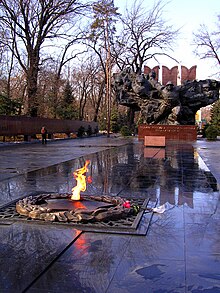
On 28 May 1887, at 4 a.m., an earthquake almost totally destroyed Verny in 11–12 minutes.[16] Brick buildings were damaged the most, as they broke apart because of lack of flexibility. As a result, people were afterward inclined to build one-storied buildings made of wood or adobe.[citation needed]
By 1906 the population of the city had grown to 27,000, two-thirds of whom being Russians and Ukrainians.
Soviet era
This section does not cite any sources. (August 2012) |

In 1918 following the Russian Revolution and the establishment of the Bolshevik government, Soviet power was established in Verny. The city and the region became part of the Turkestan Autonomous Soviet Socialist Republic (RSFSR).[17] On 5 February 1921, Verny was renamed Alma-Ata, one of the city's ancient names, by a joint consultation of regional government representatives, professional trade associations, and local faith-based groups.[18]
In 1926, the Council of Labor and Defence approved the construction of the Turkestan–Siberia Railway that was a crucial element of the future growth of Kazakhstan, especially in the east and southeast of the region. The Turkestan–Siberia Railway construction also had a decisive economic impact that strongly influenced the destiny of Alma-Ata as the capital of the Kazakh ASSR. In 1930 the construction of the highway and railway to Alma-Ata was completed.[17]
On 29 April 1927, the government decided to transfer the capital of the Kazakh Autonomous Soviet Socialist Republic from Kyzyl-Orda to Alma-Ata, within the RFSFR.[17] This attracted more trade and people working with the government, stimulating intensive development in the city.
On 31 January 1928, Leon Trotsky, leader of the 1917 October Revolution, accompanied by his wife Natalia Sedova and his son Lev Sedov, was exiled to Alma-Ata by Joseph Stalin, then head of the All-Union Communist Party (Bolsheviks) in Moscow. Trotsky was expelled from Alma-Ata to Turkey in February 1929, and went into exile in Mexico City.
The Alma-Ata airport was opened in 1930,[19] opening up a direct connection from Alma-Ata to Moscow, the center of the Soviet government. Alma-Ata became the main entry by air to Kazakhstan, a status which it retains today. Transformation of this small town into the capital of the Kazakh SSR was accelerated by the large-scale construction of new administrative and government facilities and housing. The Great Purge of 1936–38 extended to Kazakhstan, where numerous intellectuals, activists, leaders, teachers and others were killed. The Soviet government dominated the population. During the 1930s Kazakh nomads suffered starvation after disruption of their traditional living patterns. (see: Asharshylyq)
In 1936 the Architecture and Planning Bureau developed a plan to enhance Alma-Ata as the new cultural capital of the Kazakh SSR. The plan was based on the existing rectangular system of districts. They were to be strengthened and reconstructed.
World War II
During World War II the government dramatically affected the city's population and structures. To better organize the home front and concentrate industrial and material resources, the government evacuated 26,000 people and numerous industries from the European theatre of war.[20] Alma-Ata hosted over 30 industrial facilities removed from the European section of the USSR, eight evacuated hospitals, 15 institutes, universities and technical schools; and around 20 cultural institutions. Motion picture production companies from Leningrad, Kyiv, and Moscow were also moved to Alma-Ata at this time.[21] This brought in so many ethnic Russians that the Kazakhs became a minority in the region.
Over 52,000 Alma-Ata residents received the title: Gratitude for Your Self-Denying Labour. Forty-eight residents were granted the title of Hero of The Soviet Union. Three rifle divisions were raised in Alma-Ata, including the well-known 8th Guards Rifle Division 'Panfilov' (originally the 316th rifle division), along with two rifle battalions and three aviation regiments that were raised on the bases of the air club of Alma-Ata.[citation needed]
Industrialization
This section does not cite any sources. (July 2012) |
After 1941, due to the mass evacuation of factories and workers from the European part of the Soviet Union during World War II, Alma-Ata became an administrative and trading centre. Although it had an underdeveloped industrial base it became one of the largest industrial centres of the Soviet Union. It was to the rear of the wartime fronts. [citation needed]
During the years 1941–1945 the industrial potential of the city increased significantly. Development increased during the postwar years. The population of the city grew from 104,000 in 1919 to 365,000 in 1968. By 1967 the city had 145 enterprises, with the bulk of these being light and food industries.
The main industries in Alma-Ata were: food processing (36% of gross industrial output), based largely on locally abundant fruit and vegetable raw materials, light industry (31%), and heavy industry (33%). The main products of the region were:
- Food: Meat, flour and cereals (pasta factory), milk, wines, canned fruit, tobacco, confectionery, alcoholic spirits, beer, yeast, and tea (packaging)
- Light industry: textiles, fur, knitting, carpets, footwear, apparel, printing, and the Almaty Cotton combine.
- Heavy industry: electrical engineering, foundry engineering, car repair, bearing repair, building materials, woodworking, concrete structures and structural elements, and housebuilding.
Urban development

From 1966 to 1971, 1,400,000 square metres of public and cooperative housing were built. Annually, around 300,000 square metres of dwellings were under construction. Most of the buildings constructed during this time were earthquake-proof multi-story buildings. The Soviet government tried to diversify architectural forms to create a more varied cityscape. During this period, many schools, hospitals, cultural, and entertainment facilities were constructed, including Lenin's Palace, the Kazakhstan Hotel, and the Medeo Sports Complex.[22]
The Medeu Dam, designed to protect the city of Almaty and the Medeu skating rink from catastrophic mudflows during flood season, was built in 1966. It was reinforced a number of times in the 1960s and 1970s.[citation needed]
The supersonic transport Tupolev Tu-144 went into service on 26 December 1975, carrying mail and freight between Moscow and Alma-Ata in preparation for passenger services; these began in November 1977. The Aeroflot flight on 1 June 1978 was the 55th and last scheduled passenger flight of the Tu-144.
Alma-Ata was the host city for a 1978 international conference on Primary Health Care. The Alma Ata Declaration was adopted, marking a paradigm shift in global public health.
On 16 December 1986, the Jeltoqsan riot took place in the Brezhnev Square (now Republic Square) in response to General Secretary Mikhail Gorbachev's dismissal of Dinmukhamed Kunayev.[23]
On 7 September 1988, the subway Almaty Metro project started construction; the subway was opened on 1 December 2011 after 23 years.[24]
Post–independence
Kazakhstan declared its independence from the Soviet Union on 16 December 1991 (Kazakhstan Independence Day), and one year later, on 28 January 1993, the government renamed the city from the Russian Alma-Ata to the Kazakh name Almaty.[25]
In 1997 the President of the Republic of Kazakhstan Nursultan Nazarbayev approved the decree to transfer the capital from Almaty to Astana in the north of the country.[26] On 1 July 1998 a law was passed to establish the special status of Almaty as a scientific, cultural, historical, financial, and industrial centre.[25]


The new general plan of Almaty for 2030 was released in 1998. It is intended to create ecologically safe, secure, and socially comfortable living conditions in the city. The main objective is to promote Almaty's image as a garden-city.
It proposes continued multi-storied and single-housing development, reorganization of industrial districts or territories, improving transport infrastructure, and expanding the Almaty Metro. The first line of the Almaty metro was launched on 1 December 2011, two weeks ahead of schedule. The extension of the line to Qalqaman was opened in 2015.
Nevertheless, Almaty has developed a major problem with air pollution. Already in 1995, particulate emissions, then mostly from the city's thermal power station, exceeded Kazakh and EU standards by over 20 times.[27] In 2008, Almaty was ranked the 9th most polluted city in the world.[28] A 2013 study identified cars as a major source of pollution, and it was noted since 2003 and 2013 morbidity had increased by a factor of 1.5, and that the city takes the first place in the republic on respiratory, endocrine and blood diseases, cancer and bronchial asthma, even though there are no major industrial installations.[29] An independent local air quality monitoring system with a mobile app was launched in 2017.[30][31]
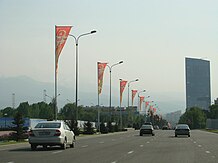
The area of the city has been expanded during recent years with the annexation of the suburban settlements of Kalkaman, Kok Tube, Gorniy Gigant District (Mountain Giant). Numerous apartment blocks and office skyscrapers have transformed the face of the town, which has been built into the mountains. Squatter settlements such as Shanyrak have resisted eviction in the face of these development plans.[32]
Almaty was the site of a notorious terrorist attack in July 2016, when Jihadist Ruslan Kulikbayev killed eight police officers and two civilians in a shootout and car chase. Kulikbayev was wounded during the shootout and later sentenced to death for the attack.
In January 2022, Almaty was plunged into unrest as part of a national political crisis.[33][34][35][36]
Administrative divisions


There are 8 official Almaty city districts :
Alatau district
Almaly district
Auezov district
Bostandyk district
Jetysu district
Medeu district
Nauryzbay district
Turksib district
Geography
Almaty is located in south-eastern Kazakhstan, almost 1000 km from the capital Astana. Kyrgyzstan's capital Bishkek is 190 km to the west, while Ürümqi in China is almost 1000 km east.
The region is also home to the Mynjylky mountain plateau, an elevated plain located at the source of the Malaya Almaatinka river at an altitude of 3000 meters above sea level.
Climate
Almaty has a humid continental climate (Köppen climate classification: Dfa) with hot summers and cold winters. It is characterized by the influence of mountain–valley circulation. This is especially evident in the northern part of the city, located directly in the transition zone of the mountain slopes to the plains.
Annual average air temperature is equal to 10 °C (50 °F), the coldest month is January, −4.7 °C (24 °F) (on average), the warmest month (July) 23.8 °C (75 °F) (on average). In average years frost starts on about 14 October and ends on about 18 April, with sustained extreme cold from about 19 December to about 23 February, a period of about 67 days. Weather with temperature above 30 °C (86 °F) is average for about 36 days a year. In the center of Almaty, like any large city, there is a "heat island" – the average daily temperature contrast between the northern and southern suburbs of the city is 3.8% in the coldest days and 2.2% in the hottest five days. Therefore, frost in the city center starts about 7 days later and finishes 3 days earlier than in the northern suburbs. Annual precipitation is about 650 to 700 mm (25.6 to 27.6 in). April and May are the wettest months, during which about a third of the city's annual precipitation is received.
It is not uncommon to see snow or a cold snap hitting Almaty as late as the end of May. For example, in the last quarter century, such snowfalls were recorded on 13 May 1985, 1 May 1989, 5 May 1993 and 18 May 1998. The record latest snowfall in Almaty was on 17 June 1987.
Almaty sometimes experiences winter rain, despite heavy preceding snowfall and low temperatures. The most memorable winter rain took place on 16 December 1996 during a military parade to celebrate the 5th anniversary of the Independence of the Republic.
Almaty Weather Station's GM mostly records south-easterly wind (30%), its resistance increases during the summer (37%) and falls in winter (19%). Wind speeds exceed 15 m/s on about 15 days a year, on average.
| Climate data for Almaty (1991–2020, extremes 1879–present) | |||||||||||||
|---|---|---|---|---|---|---|---|---|---|---|---|---|---|
| Month | Jan | Feb | Mar | Apr | May | Jun | Jul | Aug | Sep | Oct | Nov | Dec | Year |
| Record high °C (°F) | 16.8 (62.2) |
21.9 (71.4) |
29.8 (85.6) |
33.2 (91.8) |
35.8 (96.4) |
39.3 (102.7) |
41.7 (107.1) |
40.5 (104.9) |
38.1 (100.6) |
31.4 (88.5) |
26.5 (79.7) |
19.2 (66.6) |
41.7 (107.1) |
| Average high °C (°F) | 0.5 (32.9) |
2.7 (36.9) |
9.9 (49.8) |
17.8 (64.0) |
22.9 (73.2) |
27.9 (82.2) |
30.5 (86.9) |
29.7 (85.5) |
24.5 (76.1) |
16.9 (62.4) |
8.1 (46.6) |
2.0 (35.6) |
16.1 (61.0) |
| Daily mean °C (°F) | −4.6 (23.7) |
−2.4 (27.7) |
4.5 (40.1) |
12.1 (53.8) |
17.1 (62.8) |
22.1 (71.8) |
24.4 (75.9) |
23.3 (73.9) |
18.0 (64.4) |
10.6 (51.1) |
2.9 (37.2) |
−2.7 (27.1) |
10.4 (50.7) |
| Average low °C (°F) | −8.1 (17.4) |
−6.2 (20.8) |
−0.2 (31.6) |
6.8 (44.2) |
11.5 (52.7) |
16.4 (61.5) |
18.6 (65.5) |
17.3 (63.1) |
12.0 (53.6) |
5.3 (41.5) |
−1.0 (30.2) |
−6.1 (21.0) |
5.5 (41.9) |
| Record low °C (°F) | −30.1 (−22.2) |
−37.7 (−35.9) |
−24.8 (−12.6) |
−10.9 (12.4) |
−7.0 (19.4) |
2.0 (35.6) |
7.3 (45.1) |
4.7 (40.5) |
−3.0 (26.6) |
−11.9 (10.6) |
−34.1 (−29.4) |
−31.8 (−25.2) |
−37.7 (−35.9) |
| Average precipitation mm (inches) | 34 (1.3) |
43 (1.7) |
73 (2.9) |
113 (4.4) |
99 (3.9) |
59 (2.3) |
43 (1.7) |
34 (1.3) |
28 (1.1) |
49 (1.9) |
55 (2.2) |
44 (1.7) |
674 (26.5) |
| Average extreme snow depth cm (inches) | 15 (5.9) |
14 (5.5) |
5 (2.0) |
0 (0) |
0 (0) |
0 (0) |
0 (0) |
0 (0) |
0 (0) |
1 (0.4) |
2 (0.8) |
8 (3.1) |
15 (5.9) |
| Average rainy days | 4 | 5 | 11 | 14 | 15 | 15 | 15 | 10 | 9 | 10 | 8 | 6 | 122 |
| Average snowy days | 11 | 13 | 8 | 2 | 0.2 | 0 | 0 | 0 | 0.1 | 2 | 6 | 11 | 53 |
| Average relative humidity (%) | 77 | 79 | 71 | 59 | 56 | 49 | 46 | 45 | 49 | 64 | 74 | 79 | 62 |
| Mean monthly sunshine hours | 118 | 119 | 147 | 194 | 241 | 280 | 306 | 294 | 245 | 184 | 127 | 101 | 2,356 |
| Source 1: Pogoda.ru[37] | |||||||||||||
| Source 2: NOAA (sun 1961–1990)[38] | |||||||||||||
Seismic activity in the territory of Kazakhstan
This section needs additional citations for verification. (December 2013) |
Industrially developed and densely populated areas in the south and southeast of Kazakhstan are situated in the zones where the maximum magnitudes of expected earthquakes are from 6.0 to 8.3 (the intensity of I0=8–10).
The south seismic active zone of Kazakhstan is a part of the North Tian-Shan ridge system. The main city of Almaty is located near the Zailiski Alatau mountain base. In recorded history prior to the late 19th century, three catastrophic earthquakes are known to have taken place there. The following are the dates of occurrence and extracts from the historical chronicles of the times:
- 1770, "...Belovodka village was buried";
- 1807, "a horrible catastrophe took place in Almaty";
- 1865, Strong earthquake
Within the past 125 years, three more strong destructive earthquakes occurred here, with centres not more than 20–130 kilometres (10–80 mi) from the current city location. Their magnitudes were 9 and 11 on the MSK scale – 64, and their centres were located within 100 kilometres (60 mi). Centres were located in a south and south–east directions:
- (1887 y., K=17.14) Vernenskoe
- (1889 y., K=19.12) Chilik
- (1911 y., K=18.76) Keminskoe
K – indicates the energy of the earthquake.
In each of these earthquakes, the city suffered wide destruction.[39]
The Territory of the Kyrgyz State adjoins North Tian-Shan.[40]
Demographics
Almaty is the most cosmopolitan city of Kazakhstan.[7] As of 2018, ethnic Kazakhs made up 61.45% of the city population, representing an increase from 22% during the country's independence.[41]
Ethnic groups (2019):[42]
- Kazakh: 60.42%
- Russian: 25.24%
- Uyghur: 5.45%
- Korean: 1.84%
- Tatar: 1.33%
- Others: 5.72%
As of February 2015[update] the national statistics committee reported Almaty's population as 1,797,431.[5] This was a 37% increase upon the 1999 census figure of 1,129,400, and 44% higher than the 1989 USSR census figure of 1,071,900.[43]
Metropolitan area
The metropolitan area centred upon Almaty includes the cities and towns of Esik, Kaskelen, Talgar, and Kapchagay, and much of Enbekshikazakh, Jambyl, Ile, and Talgar districts, all of which lie within 1.5 hours travel of Almaty city.[44]
Culture
Almaty is largely considered to be the heart and soul of Kazakhstan's classical and popular cultures.[45] The Almaty Region and the city itself have a distinct vibe and pace compared to other regions and cities in Kazakhstan. Contemporary Almaty has a more European vibe due to more cafes and restaurants with outdoor seating and public green space.[46] Kazakh culture and zeitgeist identify as the genetic origin, or fatherland, of the wild apple Malus siversii.[47] Almaty is the historical and contemporary capital of intellectualism in Kazakhstan as a result of Almaty's location along the Ancient Silk Road and that many Russian intellectuals were exiled to the region and to Karlag.[48] The Abai Kazakh State Opera and Ballet Theatre has anchored the city's theater scene since 1934 and was founded around a community of local performance artists.[49] The Kasteyev State Museum of Arts was founded in 1935, is the largest museum in Kazakhstan, and has the largest collection of artworks by Kazakh classic and contemporary artists.[50]
Theaters
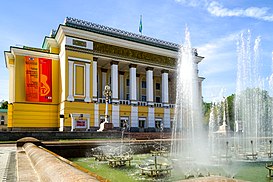
Theatrical art began to develop in the city of Verny a few years after the construction of the Russian fort. On 21 November 1872, the Society of Dramatic Art Lovers staged the first production in the city: A. N. Ostrovsky's play, "Stay in Your Own Sled". Later, plays were performed at public, military, and commercial gatherings. An abridgement of Glinka's opera "A Life for the Tsar" was the first opera staged in the city, by the Kolpakovsky three-year city school on 23 February 1913 at the Commercial Assembly, to commemorate the tercentenary of the Romanov dynasty.
The flowering of theatrical art in the city began during the Soviet period of Alma-Ata, resulting from the transfer of the capital of the Kazakh Soviet Socialist Republic from Kyzylorda to Alma-Ata. Thus, the Kazakh Drama Theater, the first Kazakh professional theater, moved to the city. In the 1930s, the Opera and Ballet Theater (1934) and the Puppet Theater (1935) were established in the city. Also, theater companies founded in different cities of the republic began to move to the capital: the Russian Drama Theater (moved from Semipalatinsk in 1934), the Uyghur Musical Comedy Theater (from Chilik, 1962), the Korean Musical Comedy Theater (from Kyzylorda, 1968), and the German Drama Theater (from Temirtau, 1989).
After Kazakhstan regained independence in 1991, a large number of new independent theaters appeared in the city. Often these are modern youth concert venues created by enthusiasts. They face funding problems, as maintaining a permanent theater company is costly.
Museums
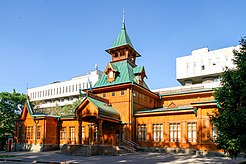
A significant contribution to the study of the history of culture, ethnography of southern Kazakhs in the late 19th–20th centuries was made by Turkestan scientists and local historians, united around the scientific societies and cultural and educational institutions of Tashkent. In 1874, from the private collections of travelers who visited Semirechye with a scientific and regional purpose and with the help of the local intelligentsia, a museum was first created in the city of Verny, which was later transformed into a village museum of the Semirechye Cossack Host. This date is the day of the foundation of the first museum in Semirechye. The foundation of the A. Kasteev Museum of Arts was laid by the Kazakh State Art Gallery named after T.G. Shevchenko, founded in 1935. Its main tasks were to collect the best works of Kazakh artists and organize their creative business trips. In 1936, museums in Moscow and Leningrad (now St. Petersburg) donated a significant number of paintings, graphics, sculpture and applied art to the gallery. By the end of the 1950s, the gallery's funds numbered over 5,000 exhibits, including paintings, reproductions of works by pre-revolutionary and Soviet artists, Western European and Eastern masters of art. In the 1970s and 1980s, new buildings were built for existing museums, and new thematic museums were opened: books, musical instruments, archeology, and others. A significant contribution to the development of the museum business was the opening of the Museum of the History of Almaty, which created an association of museums in the city of Almaty and the state institution "Gylym Ordasy", which united 4 museums, which allows to systematize scientific work.
Cinemas
The first film screening in the city of Verny took place in 1900, when the physicist K.O. Krause arrived in the city. On it, hand-painted glass transparencies were demonstrated with the help of an overhead projector. The film show took place on 25 January in the Pushkin Garden. In January 1911, the building of the first private cinema "Twentieth Century" was opened at the intersection of Pushkin and Gogol streets, which belonged to the entrepreneur A. R. Seifullin. For the demonstration of films, the cinema was equipped with the first power plant in the history of the city, produced by the British company "Petter", with 14 horsepower. The cinema building burned down in February 1918. Starting in the 1930s, summer cinemas began to appear in the parks of the city, which were later transformed into full-fledged cinemas. Thus, the Rodina Cinema was first opened in the Central Park in 1937. In 1957, it was rebuilt from a seasonal venue into a wide-screen cinema with an auditorium for 712 seats. In another park of the city, the Park of the Federation of Soviet Republics, the Progress Cinema was opened, later renamed Alma-Ata. By the early 1990s, there were 21 cinemas in the city. All cinemas were divided into first, second and third screens. The cinemas of the first screen, in which the premieres of new films took place, were "Alatau", "Tselinny" and "Arman". Film films arrived at the cinemas of the third screen in a deplorable state, with glues and cuts. That is, the quality of showing the film depended on the screening of the cinema. Cinemas in the city were single-screen, two halls were owned by the cinema centers "Kazakhstan", "Arman" and "Tselinny". In the 2000s, cinemas began to open in shopping and entertainment centers, and as a result, existing stationary cinemas began to lose popularity and close.
Economy
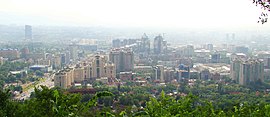
Almaty generates approximately 20% of Kazakhstan's GDP (or $36 billion in 2010). The city accounts for above 20% of government revenues and 60% of bank credits.[51] The nation is the most powerful economically in Central Asia and Almaty is a key financial center. It is considered to be a Beta- Global City as of the 2012 GaWC study.[52]
One of the largest industries in Almaty is finance, and its financial exports make it a large contributor to Kazakhstan's balance of payments. Almaty is home to Halyk Bank, which is the largest bank in Central Asia, Kaspi Bank, and other major banks. The Kazakhstan Stock Exchange is based in Almaty.
Almaty is also developing as a regional financial and business centre (RFCA).[53]
Under construction is the 'Almaty Financial District and Esentai Park'. This was designed by T.J. Gottesdiener, who designed both 7 World Trade Center in New York City and Tokyo Midtown. Its goal is to become the largest business centre in Central Asia. [citation needed] Esentai Tower, a 37-floor building in the park, is the tallest mixed-use building in Kazakhstan, housing offices of companies such as Ernst & Young, HSBC and Credit Suisse. The first Ritz-Carlton Hotel in Kazakhstan opened in 2013 in Esentai Tower.[54]
Along with professional services, media companies are concentrated in Almaty. The media distribution industry has been growing rapidly since 2006. Major broadcasting channels KTK and NTK are based in Almaty, as are several national newspapers.
There are plans to construct a Western Europe-Western China highway, passing through Almaty. A new airport in Almaty expects to handle about 45 million tonnes of cargo each year. Air Astana is headquartered in the Air Astana Centre 1 in Almaty.[55] Prior to their dissolution, Air Kazakhstan[56] and Kazakhstan Airlines[57] were also headquartered in Almaty.
The economy of Almaty and Almaty Region continues to grow, and is expected to increase by nearly 6.5 percent per year until 2020.[58] To mitigate the rapidly increasing electricity demand caused by this growth, the Kazakh authorities decided to upgrade the power system by building the new transmission line and modernizing the substations.[58] The Alma Transmission Project, supported by the World Bank, has helped achieve this goal.[58]
Cityscape

In 1854, the Tsarist government built a military fortification on the left bank of the Almaty River. The construction was supervised by Major Peremyshelsky and engineer-lieutenant Aleksandrovsky. By the autumn of the same year, construction work was completed. With their arrival, the area of Almaty began to develop rapidly, and a few prominent buildings were constructed during this time including the Little Stanitsa and the Tatar Slobodka. A major earthquake in 1887 destroyed 1798 brick houses and killed 322 people. After the earthquake, numerous notable buildings were constructed including the House of the Regiment of Military Assembly (1908), Ascension Cathedral, the House of Public Assembly, and others. Paul Gourdet, who is credited for most of Almaty's urban architecture of the time, used an approach to design Russian Revival architecture, which is evident in some of his designs including the Medical College, the Voznesensky Cathedral, the merchant Shakhvorostov's house, the former Women's College, the former City Orphanage, and numerous other buildings. Andrei Zenkov is another prominent architect and major contributor to some of Almaty's most notable buildings. At the time, Zenkov was in charge of the construction projects of the Semirechye regional government.
From 1966 to 1972, most of the buildings constructed during the era were earthquake-proof multi-story housing blocks. During this period, many schools, hospitals, cultural, and entertainment facilities were constructed in post-modernist style, including Lenin's Palace (now Palace of the Republic, 1970), Hotel Kazakhstan (1977) and the Medeu (1971).
Attractions
Churches

- St. Sophia Cathedral (Almaty)
- The Ascension Cathedral is a 56 m high earthquake-resistant structure, built by the architect K. A. Borisoglebsky and engineer A. P. Zenkov in 1907 from blue Tien Shan spruce. It withstood an earthquake with a force of 10 points in 1911. The walls of the cathedral were painted by the local artist N. Khludov. During the Soviet period, the building housed a local history museum. In May 1995, the building was transferred to the Almaty and Semipalatinsk Diocese of the Russian Orthodox Church. After two years of restoration work, services were resumed in the church in 1997.
Fountains
According to the city's Department of Natural Resources and Resource Use Management,[59] as of 2007[update] the city had 125 fountains. Among them is the "Oriental Calendar" Fountain, whose 12 sculptural figures represent the 12 animals of the Kazakh 12-year animal cycle (similar to its Chinese counterpart).
There are now more than 120 fountains in Almaty, 61 of which are communally owned. Fountains, together with an extensive irrigation ditch network, play a big role in Alma-Ata – together they create a single complex of reservoirs and watercourses of the city. Every year at the end of spring, the city celebrates the "Day of Fountains" holiday where for the first time after winter, all the city's fountains are turned on. In 2006, a new fountain was opened on Lake Sayran. Previously, the highest fountain in the Commonwealth of Independent States (CIS) gushed from this lake– a stream of water 10 cm in diameter reached a height of 50 meters. The fountain has been closed since 2008.
- Fountain in First President's Park
- Zodiac Fountain
- Nedelka Prospect
- Fountains in Republic Square
- Fountain in Abai Square
- East Fountain
Recreation
Medeu
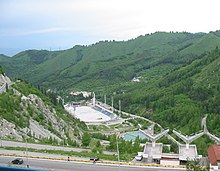
The Medeu is an outdoor speed skating and bandy rink. It is located in a mountain valley (Medeu Valley, or the valley of Malaya Alma-Atinka River) on the south-eastern outskirts of Almaty, Kazakhstan. Medeu sits 1,691 metres above sea level, making it one of the highest skating rinks in the world. It has 10,500 square meters of ice and utilizes a sophisticated freezing and watering system to ensure the quality of the ice.
Medeu was built in 1972 in the gorge of the same name, 15 km from the city. "Medeo" was called "the factory of records", since 126 world records were set on the ice of a high-mountain skating rink in 33 years. A unique feature of the ice rink, located at an altitude of 1700 m, in thin air and high quality ice, provided by pure mountain water without admixture of salts. In addition, Above the sports complex there is a mudflow protection dam and the Shymbulak. In the 1990s, the Medeu was the venue for the Voice of Asia international music festival (Asia Dauysy).
Şymbūlaq
Şymbūlaq is a ski resort near Almaty, located in the upper part of the Medeu Valley in the Zailiisky Alatau mountain range, at the elevation of 2,200 metres (7,200 ft) above sea level. The resort area is about 25 kilometres (16 mi) south of Almaty city by the Medeu road. It is popular for its mild climate, a large quantity of sunny days and a great amount of snow through the winter (from November until May). The resort offers both day and night skiing.
Big Almaty Lake
Big Almaty Lake is a natural lake located in Trans-Ili Alatau mountains on 2511 above the sea level near Almaty (15 km South from Almaty). Like a majority of lakes in Trans-Ili Alatau, this lake formed as the result of an earthquake. The lake is a major source of drinking water for the region. People can access the lake by car (approximately 1 hour drive from the city center), bike, or hiking (approximately a half-day trip).
First President's Park

The First President's Park is an urban park located in Almaty at the intersection of Navoi Street and Al-Farabi Avenue in the Bostandyq District. The park was opened in July 2010.
Creation of the park began in 2001. The park is broken into three main areas–the avenue, boulevard, and dendrological areas. Greenery was planted according to dendrological plan. In honor of the participation of the city of Almaty in the Olympic torch relay of the Beijing Olympic Games, approximately one hundred spruces and birches were planted. In 2011, a hundred Tien-Shan spruces were also planted. Plans include a set of water projects over an area of 9.5 hectares.
Kök Töbe
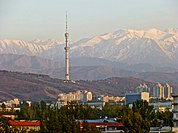
An aerial tramway line connects Almaty with a popular recreation area at the top of Kök Töbe (Kazakh: Көк-төбе, which means 'Blue Hill'), a mountain just to the southeast. It has a variety of tourist attractions, such as a zoo, amusement-park-style rides and restaurants.
The city television tower, Almaty Tower, is located on the hill. It was built in between 1978 and 1983, and is 371.5 m tall.[60] The TV tower, located at an altitude of 1000 m above sea level, is the tallest structure in Almaty. Its height is almost 372 m, and it sits at an elevation of 1130 m. The base of the tower is a reinforced concrete foundation in the form of a three-storey sectional basement. The barrel of the tower is a metal stepped hexahedron with a diameter of 18 m at the base, 13 and 9 m at the locations of maintenance services at heights of 146 and 252 m. The structure was built taking into account the seismic mountainous terrain and can withstand an earthquake of up to 10 points. The television tower is a complex of an operating radio and television transmitting station with a special mode of operation, therefore it is inaccessible for sightseeing tours of the city from a height. The tower, illuminated at night by powerful searchlights, is visible from almost anywhere in the city.
Park of 28 Panfilov Guardsmen
The Park of 28 Panfilov Guardsmen is a major park in Almaty, Kazakhstan. The park is located in east-central Almaty in the area surrounding Zenkov Cathedral. It is dedicated to and named after the Panfilov Heroes, 28 soldiers of an Almaty infantry unit who died fighting Nazi German invaders outside of Moscow in World War II. The group takes its name from Ivan Panfilov, the General commanding the 316th division which, in spite of heavy casualties, believed at that time managed to significantly delay the Germans' advance on the capital, buying time for the defenders of the city. An eternal flame commemorating the fallen of the Russian Civil War and the Great Patriotic War burns in front of the giant black monument of soldiers from all 15 Soviet republics.
- Panfilov Park
- Kök Töbe cable car, 2007
- Shymbulak Valley
- Watchtower in middle of Big Almaty Lake
Transportation
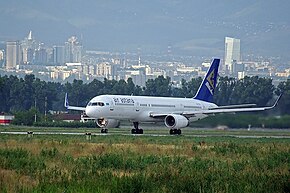
Air
The closest airport to Almaty is Almaty International Airport located 15 kilometres (9+1⁄2 mi) northeast of the city centre.
Urban transport
Sayran Bus Terminal provides intercity bus connections within Kazakhstan, as well as international connections to Kyrgyzstan and China and regional bus connections west of the city. Sayakhat bus terminal provides regional bus connections to places north and east of the city.[61]
Kazakhstan Temir Joly's has two stations Almaty-1 (located 20 minutes drive from Almaty, and reserved mostly for cargo) and Almaty-2 located within the city and reserved mostly for passengers.[62] In 2011 the Almaty Metro opened, and a light rail line is planned.
A bicycle-sharing system, Almaty-bike, has been in operation since September 2016.[63] People can buy a monthly card and ride freely.
Education
Universities
Kazakh National Medical University, named after Asfendiyarov (former: Almaty Governmental Medical Institute (AGMI))
- Almaty Management University (ALMU)
- International Information Technology University (IITU)
- Kazakh-British Technical University (KBTU)
- University of International Business
- Kazakh National Medical University
- Almaty Institute of Power Engineering and Telecommunications
- Kazakh National Technical University (KazNTU)
- Al-Farabi Kazakh National University (KazNU)
- Suleyman Demirel University (SDU)
- KIMEP University (KIMEP)
- Kazakh-American University (KAU)
- Kazakh National Academy of Arts named by T.Zhurgenov
- Kazakh Academy of Sciences
- Kazakh Academy of Labour and Social Relations
- Kazakh National Pedagogic University (named after Abay)
- Turan University
- Kazakh Ablai Khan University of International Relations and World Languages
- Central Asian University (ЦАУ)
- Kazakh-German University (КНУ)
- Kazakh Leading Academy of Architecture and Civil Engineering
- Kazakh National Agrarian University (SHI, AEZVI)
- Narxoz University
- International Business Academy
Sport

The historic bandy team Dinamo won the Soviet Championships in 1977[64] and 1990[65] and the European Cup in 1978. Their home ground was Medeu. Bandy was introduced for the first time at the 2011 Winter Asian Games.[66] Medeu was the main arena at the 2012 Bandy World Championship.[67] The second arena built for the championships is an alternative field at Almaty Central Stadium.[68] The city is now a candidate to host also the 2020 Bandy World Championship.[69] The Federation of International Bandy has opened an office for Asia, which is located in Almaty.[70]
Almaty was the host of the 2017 Winter Universiade[71] with bandy on the programme.[72]
The 2011 Asian Winter Games were held jointly in Almaty and Astana. The ice hockey and ski jumping competitions were held in the city at the Baluan Sholak Sports Palace and Sunkar International Ski Jumping Complex respectively. The biathlon, cross-country skiing, and ski orienteering competitions were held at the nearby Soldatskoe Valley Cross Country Skiing and Biathlon Stadium; the Alpine skiing and bandy competitions were held in nearby Shymbulak and Medeo respectively.
The Yenbek Almaty ice hockey team played from 1965 to 1985 and from 1999 to 2009. HC Almaty currently plays in the Kazakhstan Hockey Championship.
The city's primary football team is FC Kairat founded in 1954 and one of the most successful Kazakh clubs. Futsal club AFC Kairat hs won the UEFA Futsal Cup in 2012–13 and 2014–15. Basketball team BC Almaty won the 2015 and 2016 editions of the Kazakhstan Basketball Cup.
Olympic aspirations
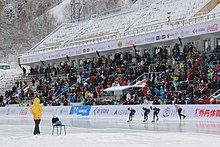
Following the successful hosting of the 2011 Winter Asian Games, Almaty made a bid to host the XXII Olympic Winter Games in 2014,[73] but was eliminated from consideration, not making the "short list" of candidate cities. Almaty was the 2017 Winter Universiade host.[74] The city was exploring possible bids, such as the 2018 Winter Olympics, but did not submit one. Almaty submitted a bid to host the 2022 Winter Olympics in August 2013,[75][76] but lost to Beijing.[77] Despite these failures, Almaty may still consider to submit a bid to host the 2030 Winter Olympics.[78][79]
In popular culture
The fictional espionage novel Performance Anomalies[80] takes place in Almaty, Kazakhstan and many of the city's landmarks make an appearance, including Panfilov Park,[81] Zenkov Cathedral, The Kazakh Museum of Folk Musical Instruments, Kok-Tob (Kök Töbe), Shymbulak, Zelyony Bazaar, and several well-known avenues.[82][83]
Notable residents
- Zhansaya Abdumalik (born 2000), chess Woman Grandmaster (WGM) and chess prodigy
- Altynai Asylmuratova (born 1961), prima ballerina with the Kirov ballet
- Eugen Bauder (born 1986), model in Germany
- Anatoly Bose (born 1988), Australian basketball player
- Alexander Brener (born 1957), film star in Russia
- Sergei Chekmezov (born 1964), professional football coach and former player
- Zarina Diyas (born 1993), tennis player
- Alexandra Elbakyan (born 1988), intellectual property activist, creator of Sci-Hub
- Nagima Eskalieva (born 1954), singer and entertainer
- Dmitri Fofonov (born 1976), Racing cyclist
- Alexey Korolev (born 1987), ski jumper
- Nikolay Karpenko (born 1981), ski jumper
- Ruslana Korshunova (1987–2008), model in Russia
- Olessya Kulakova (born 1977), volleyball representative for Germany
- Regina Kulikova (born 1989), tennis player
- Dinmukhamed Konayev (1912–1993), politician
- Fuat Mansurov (1928–2008), Soviet and Russian conductor
- Dmitriy Ogai (born 1960), soccer trainer and Soviet soccer player
- Sergei Ostapenko (born 1986), soccer player
- Alexander Parygin (born 1973), olympic athlete
- Alexander Petrenko (1976–2006), basketball representative for Russia
- Boris Polak (born 1954), Israeli world champion and Olympic sport shooter
- Vadim Sayutin (born 1970), ice speed skater in Russia
- Thomas Schertwitis (born 1972), water polo
- Olga Shishigina (born 1968), Olympic Champion in hurdling
- Konstantin Sokolenko (born 1987), Nordic combined skier/ski jumper
- Igor Sysoev (born 1970) open-source software engineer, founder of nginx, Inc.
- Elena Likhovtseva (born 1975), tennis player
- Denis Ten (1993-2018), figure skater
- Yernar Yerimbetov (1980), gymnast
- Anatoly Vaisser (born 1949), French chess grandmaster
- Radik Zhaparov (born 1984), ski jumper
- Vladimir Zhirinovsky (1946–2022), politician
- Elena Zoubareva (born 1972), opera singer
Twin towns – sister cities
Almaty is twinned with:[84]
 Alexandria, Egypt[85]
Alexandria, Egypt[85] Bishkek, Kyrgyzstan[86]
Bishkek, Kyrgyzstan[86] Daegu, South Korea
Daegu, South Korea Istanbul, Turkey
Istanbul, Turkey Jeddah, Saudi Arabia
Jeddah, Saudi Arabia Malatya, Turkey[87]
Malatya, Turkey[87] Modena, Italy[88]
Modena, Italy[88] Mogadishu, Somalia[89]
Mogadishu, Somalia[89] Moscow, Russia
Moscow, Russia Rennes, France
Rennes, France Riga, Latvia
Riga, Latvia Rosario, Argentina[90]
Rosario, Argentina[90] Saint Petersburg, Russia
Saint Petersburg, Russia Tashkent, Uzbekistan
Tashkent, Uzbekistan Tel Aviv, Israel
Tel Aviv, Israel Tucson, Arizona, United States
Tucson, Arizona, United States Ürümqi, China
Ürümqi, China Vilnius, Lithuania
Vilnius, Lithuania
Gallery
- A modern Almaty street
- The Central State Museum of Kazakhstan
- Lake Sayran, on the western side of the city
- Aerial view of Raymbek avenue
- Raymbek batyr Station, Almaty Metro
- The Ascension Cathedral in winter
- Bronze statues of The Beatles by sculptor Eduard Kazaryan
- Old House, constructed in 1908, at Furmanov street
- The Musrepov Academic Youth Theater
- The Medeo ice skating stadium
- Al-Farabi Kazakh National University
- Fountain in Almaty
- Almaty 1 train station
- City border
- Statue of Vladimir Lenin
International organizations
The International Monetary Fund announced in October 2019 that it would launch a new regional technical assistance centre (RTAC) in Almaty. The centre will provide capacity development services to nine IMF member countries in the CCAM region. The centre is expected to cover the fiscal policy, central bank operations, financial sector supervision, and macroeconomic statistics.[91]
See also
- Almaty International School
- A. Kasteyev State Museum of Arts
- Alma Ata Declaration
- Almaty International Airport
- Architecture of Almaty
- Central State Museum of Kazakhstan
- FC Kairat
- Kazakhstan International School
- Kazakhstan National Museum of Instruments
- Monuments of Almaty
- Malus sieversii
- Shymbulak – ski resort
- WikiBilim Public Foundation
- The Golden Square (Almaty)
References
- "KAZAKHSTAN: Administrative Division". citypopulation.de. Archived from the original on 21 January 2019. Retrieved 20 January 2019.
- "Об изменении численности населения города Алматы с начала 2020 года до 1 января 2021 года". Комитет по статистике Министерства национальной экономики Республики Казахстан. Archived from the original on 25 May 2021. Retrieved 17 February 2021.
- "Code of Access". Almaly.almaty.kz. Archived from the original on 14 August 2014. Retrieved 2 January 2012.
- "Sub-national HDI – Area Database – Global Data Lab". hdi.globaldatalab.org. Archived from the original on 23 September 2018. Retrieved 21 July 2021.
- "Об изменении численности населения Республики Казахстан с начала 2017 года до 1 декабря 2017 года (Citizenship of the Republic of Kazakhstan ... to 1 December 2017)" (in Russian). Stat.gov.kz. 4 January 2018. Archived from the original on 23 January 2018. Retrieved 22 January 2018.
- "Население". Stat.kz. Archived from the original on 4 January 2013. Retrieved 11 January 2013.
- Brummell, Paul; Oleynik, Maria (2018). Kazakhstan. Bradt Travel Guides. p. 26. ISBN 9781784770921. Archived from the original on 28 June 2018. Retrieved 27 June 2018.
- "Almaty, Kazakhstan" Archived 20 November 2015 at the Wayback Machine, Encyclopædia Britannica
- "Almaty included into network of the creative cities of UNESCO" (in Russian). Retrieved 3 October 2018.[permanent dead link]
- "History and meaning of the city names in Kazakhstan – статьи, истории, публикации | WEproject". weproject.kz (in Russian). Archived from the original on 25 September 2017. Retrieved 25 September 2017.
- Nabhan, Gary Paul (May–June 2008). "The Fatherland of Apples". Orion Magazine. Archived from the original on 23 September 2014. Retrieved 4 February 2013.
- "History of Almaty". Almaty.kz. Archived from the original on 19 January 2012. Retrieved 2 January 2012.
- Ness, Immanuel. Encyclopedia of World Cities. M E Sharpe Reference, 1999. ISBN 0-7656-8017-3. Page 19.
- Archived 8 January 2009 at the Wayback Machine
- "History of Almaty". Archived from the original on 25 September 2017.
- "History of Almaty :: Echoes of Past Centuries. Almaty history. The city of Almaty". kazakhstan.orexca.com. Archived from the original on 25 September 2017. Retrieved 25 September 2017.
- "Как переносили столицу из Кзыл-Орды в Алма-Ату – Аналитический интернет-журнал Vласть". vlast.kz (in Russian). Retrieved 9 March 2022.
- Ахметов, Альберт (5 February 2021). "100 лет назад Верный стал Алма-Атой: Как это было". zakon.kz (in Russian). Retrieved 9 March 2022.
- "История авиации Алматы.Теги: обсуждение истории развития; изучение биографии авиаторов; история авиации". aviaengeneer.ru (in Russian). Retrieved 9 March 2022.
- "Эвакуация населения и промышленности из западныз районов СССР в Северо-Казахстанскую область (1941-1943 гг.)". e-history.kz (in Russian). Retrieved 9 March 2022.
- "История театра | Государственный театр кукол". puppet.kz (in Russian). Retrieved 9 March 2022.
- "Спортивный комплекс Медеу в Алматы". alnaz.ru. Retrieved 9 March 2022.
- "Nationalist riots in Kazakhstan: Violent nationalist riots erupted in Alma-Ata, the capital of Kazakhstan, on 17 and 18 December 1986"
- "В Алматы открылся Метрополитен (фото)". Zakon.kz. Archived from the original on 2 April 2015. Retrieved 20 June 2015.
- "History of Almaty". Archived from the original on 6 April 2018. Retrieved 6 April 2018.
- Archived 26 November 2007 at the Wayback Machine
- CRE Group (1995). Almaty Air Quality Study (TA 2262-Kaz) (PDF) (Report). Asian Development Bank. p. i. Archived (PDF) from the original on 22 January 2018. Retrieved 22 January 2018.
- "Almaty is one of ten most polluted cities in the world". Kazakhstan Today. 5 March 2008. Archived from the original on 22 January 2018. Retrieved 22 January 2018.
- Carlsen, Lars; Baimatova, Nassiba; Kenessov, Bulat; Kenessova, Olga (2013). "Assessment of the Air Quality of Almaty. Focussing on the Traffic Component". International Journal of Biology and Chemistry. 5 (1): 49–69. Archived from the original on 22 January 2018. Retrieved 21 January 2018.
- Shatayeva, Lyazzat (2 February 2017). "New App Helps Almaty Residents Monitor Air Quality". Astana Times. Archived from the original on 22 January 2018. Retrieved 22 January 2018.
- "Almaty Urban Air". auagroup.kz. Archived from the original on 22 January 2018. Retrieved 22 January 2018.
- Alexander, Catherine (June 2018). "Homeless in the homeland: Housing protests in Kazakhstan" (PDF). Critique of Anthropology. 38 (2): 204–220. doi:10.1177/0308275x18758872. S2CID 148583852. Archived (PDF) from the original on 21 December 2018. Retrieved 8 November 2021.
- "Kazakhstan protests: government resigns amid rare outbreak of unrest". The Guardian. 5 January 2022. Archived from the original on 5 January 2022. Retrieved 5 January 2022.
- "Kazakhstan protests: Russia sends in troops to stop deadly uprising". The Independent. Archived from the original on 5 January 2022. Retrieved 9 January 2022.
- Picheta, Rob. "Russia-led military alliance CSTO will send 'peacekeepers' to protest-hit Kazakhstan, Armenian PM says". CNN. Archived from the original on 5 January 2022. Retrieved 9 January 2022.
- By bne correspondent in Almaty. (25 March 2021). "bne IntelliNews – Fake news? Conflicting reports of shooting in Almaty as Russian and Kazakh governments appear to manipulate reporting for own agendas". Intellinews.com. Archived from the original on 6 January 2022. Retrieved 9 January 2022.
- "Climate of Almaty". Погода и Климат. Archived from the original on 14 February 2015. Retrieved 8 November 2021.
- "Almaty Climate Normals 1961–1990". National Oceanic and Atmospheric Administration. Archived from the original on 9 November 2021. Retrieved 8 November 2021.
- (Baimakhan, Dashdorj, 2006)
- (Aitmatov, Kojogulov, Nikolskaya, 1994.).
- Lillis, Joanna (20 March 2019). "Dark Shadows: Inside the Secret World of Kazakhstan". Archived from the original on 22 March 2019. Retrieved 25 November 2019.
- "Численность населения Республики Казахстан по отдельным этносам на начало 2020 года". Stat.kz. Archived from the original on 8 November 2017. Retrieved 2 August 2020.
- "О некоторых итогах переписи населения Казахстана". Demoscope.ru. Archived from the original on 3 March 2016. Retrieved 20 June 2015.
- Dosayev, Yerbolat. "Досье на проект постановления "Об утверждении Долгосрочного плана формирования и развития Алматинской агломерации до 2030 года"". Bestprofi.
- "Almaty Arts & Culture". edgekz. Archived from the original on 26 October 2020. Retrieved 25 May 2020.
- "Almaty: An Emerging Destination For Global Travelers and a Center of Culture For Locals". Forbes. Archived from the original on 25 July 2020. Retrieved 25 May 2020.
- "I Went to the Fatherland of All Modern Apples". VICE. Archived from the original on 26 July 2020. Retrieved 25 May 2020.
- Abdrakhmanova, K.K. "The scientific and creative intelligence of Karlag: the historiographical aspect". Karaganda State University Repository. Karaganda State University. Archived from the original on 25 July 2020. Retrieved 26 May 2020.
- "Kazakh State Academic Theater named after Abay". gatob.kz. Kazakh State Academic Theater. Archived from the original on 26 May 2020. Retrieved 26 May 2020.
- "A. Kasteyev State Museum of Arts". gmirk.kz. Archived from the original on 30 April 2020. Retrieved 26 May 2020.
- "President: Almaty turns into large regional investment attractive centre". inform.kz. 29 October 2019. Archived from the original on 30 October 2019. Retrieved 31 October 2019.
- "GaWC – The World According to GaWC". Lboro.ac.uk. Archived from the original on 30 November 2012. Retrieved 20 June 2015.
- "National Bank of Kazakhstan". Archived from the original on 27 July 2016.
- "Ritz-Carlton Plans Kazakhstan Debut by End of 2013". The Gazette of Central Asia. Satrapia. 4 December 2012. Archived from the original on 9 January 2022. Retrieved 5 December 2012.
- Archived 28 July 2010 at the Wayback Machine
- "air jamaica | 2004 | 09 – 0068 | Flight Archive". Flightglobal.com. Archived from the original on 8 July 2017. Retrieved 20 June 2015.
- "1995 | 0880 | Flight Archive". Flightglobal.com. Archived from the original on 8 July 2017. Retrieved 20 June 2015.
- "Keeping the Lights on in Kazakhstan's Largest City". worldbank.org. Archived from the original on 3 May 2015. Retrieved 1 May 2015.
- "Заголовок :: Новости :: Департамент экологии Акимата г. Алматы – экол…". 21 May 2007. Archived from the original on 21 May 2007. Retrieved 23 October 2017.
- "Almaty Tower". Samarkand Tours Operator. Archived from the original on 9 January 2022. Retrieved 26 December 2020.
- "Bus stations in Almaty". Caravanistan. Archived from the original on 30 March 2015. Retrieved 2 September 2015.
- "Almaty train station – Caravanistan". Caravanistan. Archived from the original on 31 March 2015. Retrieved 23 October 2017.
- Times, Astana (4 July 2016). "Almaty Bike System to be Launched in September". The Astana Times. Retrieved 8 November 2022.
- "Team picture of the 1977 league champions" (JPG). Akzhajik.ucoz.kz. Archived from the original on 4 March 2016. Retrieved 20 June 2015.
- "Team picture of the 1990 league champions". Akzhajik.ucoz.kz. Archived from the original (JPG) on 9 December 2011. Retrieved 20 June 2015.
- [dead link]
- emh solutions. "Matches on the high-latitude arena Medeu | Federation of International Bandy". Worldbandy.com. Archived from the original on 20 June 2015. Retrieved 20 June 2015.
- "Google Translate". Translate.google.ca. 7 January 2013. Archived from the original on 7 August 2013. Retrieved 11 January 2013.
- "Google Translate". translate.google.co.uk. 4 February 2017. Retrieved 23 October 2017.
- "Google Translate". Translate.google.ca. 7 January 2013. Archived from the original on 4 March 2016. Retrieved 11 January 2013.
- "2017 Winter Universiade home page". Almaty2017.kz. 11 November 2011. Archived from the original on 26 April 2012. Retrieved 3 March 2012.
- "The Universiade in Almaty could serve as an Impetus to the Development of Bandy". Fisu.net. Archived from the original on 31 July 2012. Retrieved 3 March 2012.
- "2014 Winter Olympic Games Bids". Gamesbids.com. Archived from the original on 23 March 2007. Retrieved 2 January 2012.
- "Almaty 2017 home page". Almaty2017.kz. 11 November 2011. Archived from the original on 5 December 2011. Retrieved 2 January 2012.
- "Kazakhstan's Almaty bids to host 2022 Winter Games". Espn.go.com. 19 August 2013. Archived from the original on 21 August 2013. Retrieved 20 June 2015.
- Archived 6 October 2014 at the Wayback Machine
- "Beijing to host 2022 Winter Olympics". BBC Sport. 31 July 2015. Archived from the original on 2 August 2015. Retrieved 31 July 2015.
- "Winter Olympic Games Almaty-2030". Forbes Life. 3 October 2021. Retrieved 5 January 2022.
{{cite news}}: CS1 maint: url-status (link) - "Is Almaty actually the perfect fit for 2030? (.....seriously)". Gamesbids.com. Archived from the original on 5 January 2022. Retrieved 5 January 2022.
- Lee, Victor Robert (20 December 2012). Performance Anomalies. USA: Perimeter Six. ISBN 9781938409226.
- Panfilov Park
- "11 Best Books about Kazakhstan | Caravanistan". Caravanistan. Archived from the original on 7 May 2017. Retrieved 11 May 2017.
- Performance Anomalies | ReadingGroupGuides.com. Archived from the original on 3 August 2017. Retrieved 11 May 2017.
- "Есть ли побратимы у Актау и других городов Казахстана". tumba.kz (in Russian). Tumba. 4 May 2019. Archived from the original on 12 December 2020. Retrieved 30 November 2020.
- "Музыкальные инструменты мира» соберутся в Алматы". inalmaty.kz (in Russian). inAlmaty. 11 September 2018. Archived from the original on 10 December 2020. Retrieved 30 November 2020.
- "Балбак Түлөбаев Казакстандын элчиси менен жолугушту". vesti.kg (in Kyrgyz). Vesti.kg. 23 November 2020. Archived from the original on 11 December 2020. Retrieved 30 November 2020.
- "Almatı". malatya.bel.tr (in Turkish). Malatya. Archived from the original on 12 November 2020. Retrieved 13 November 2020.
- "Cosa accomuna Modena al Kazakistan?". modenatoday.it (in Italian). Modena Today. 9 November 2020. Archived from the original on 5 March 2021. Retrieved 13 November 2020.
- USSR and Third World, Volume 3. Central Asian Research Centre. 1973. p. 209. Archived from the original on 11 June 2014. Retrieved 27 February 2016.
- "Relaciones bilaterales". rosario.gob.ar (in Spanish). Rosario. 26 April 2019. Archived from the original on 6 June 2020. Retrieved 13 November 2020.
- "IMF to locate new regional technical assistance centre in Almaty". astanatimes.com. 23 October 2019. Archived from the original on 23 October 2019. Retrieved 23 October 2019.
Further reading
External links
- City of Almaty Archived 15 June 2020 at the Wayback Machine Official website
- Almaty Tourism Website
 Almaty travel guide from Wikivoyage
Almaty travel guide from Wikivoyage- Link to Almaty airport
- New buildings and developers of Almaty
На других языках
[de] Almaty
Almaty (kasachisch und russisch Алматы .mw-parser-output .Latn{font-family:"Akzidenz Grotesk","Arial","Avant Garde Gothic","Calibri","Futura","Geneva","Gill Sans","Helvetica","Lucida Grande","Lucida Sans Unicode","Lucida Grande","Stone Sans","Tahoma","Trebuchet","Univers","Verdana"}/ Almaty, in der neuen inoffiziellen Lateinschrift Almatı, bis 1998: Alma-Ata) ist mit rund zwei Millionen Einwohnern die größte Stadt Kasachstans. Sie liegt im Südosten des zentralasiatischen Staates unweit der Grenze zu Kirgisistan, war von 1936 bis 1991 Hauptstadt der Kasachischen SSR und nach dem Zerfall der Sowjetunion bis 1997 von Kasachstan.- [en] Almaty
[es] Alma Ata
Almaty[1] (en kazajo, Алматы, romanizado: Almatí, pronunciado /ɑlmɑˈtə/ (?·i); en ruso, Алма-Ата), también llamada Almatý e históricamente Verni (Верный) en la Rusia imperial, es la ciudad más grande de Kazajistán, con una población de 2 039 376 personas, aproximadamente el 11 % de la población total del país[2] y más de 2.7 millones en su área urbanizada, que abarca Talgar, Boraldai, Otegen Batyr y muchos otros suburbios. Fue capital de la RSS de Kazajistán de 1929 hasta 1991 y luego de la República independiente de Kazajistán desde 1991 hasta 1997,[3] fecha en que el gobierno trasladó la capital a Nursultán al norte del país y a 12 horas en tren.[ru] Алма-Ата
Алма́-Ата́[4][5][6][7][8], Алматы́[9][10] (каз. Алматы, Almaty (инф.)[11]; до 1921 года — Ве́рный[4]) — город республиканского значения в Казахстане, бывшая столица Республики Казахстан (до 1997 года), Казахской ССР (в составе СССР; до 1991 года), Казакской АССР (в составе РСФСР; до 1936 года), бывший административный центр Алматинской области (до 2001 года).Другой контент может иметь иную лицензию. Перед использованием материалов сайта WikiSort.org внимательно изучите правила лицензирования конкретных элементов наполнения сайта.
WikiSort.org - проект по пересортировке и дополнению контента Википедии
